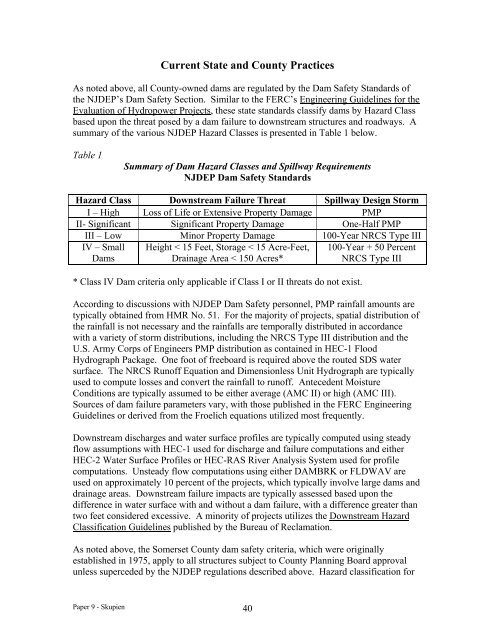Hydrologic Issues for Dams - Association of State Dam Safety Officials
Hydrologic Issues for Dams - Association of State Dam Safety Officials
Hydrologic Issues for Dams - Association of State Dam Safety Officials
You also want an ePaper? Increase the reach of your titles
YUMPU automatically turns print PDFs into web optimized ePapers that Google loves.
Current <strong>State</strong> and County PracticesAs noted above, all County-owned dams are regulated by the <strong>Dam</strong> <strong>Safety</strong> Standards <strong>of</strong>the NJDEP’s <strong>Dam</strong> <strong>Safety</strong> Section. Similar to the FERC’s Engineering Guidelines <strong>for</strong> theEvaluation <strong>of</strong> Hydropower Projects, these state standards classify dams by Hazard Classbased upon the threat posed by a dam failure to downstream structures and roadways. Asummary <strong>of</strong> the various NJDEP Hazard Classes is presented in Table 1 below.Table 1Summary <strong>of</strong> <strong>Dam</strong> Hazard Classes and Spillway RequirementsNJDEP <strong>Dam</strong> <strong>Safety</strong> StandardsHazard Class Downstream Failure Threat Spillway Design StormI – High Loss <strong>of</strong> Life or Extensive Property <strong>Dam</strong>age PMPII- Significant Significant Property <strong>Dam</strong>age One-Half PMPIII – Low Minor Property <strong>Dam</strong>age 100-Year NRCS Type IIIIV – Small<strong><strong>Dam</strong>s</strong>Height < 15 Feet, Storage < 15 Acre-Feet,Drainage Area < 150 Acres** Class IV <strong>Dam</strong> criteria only applicable if Class I or II threats do not exist.100-Year + 50 PercentNRCS Type IIIAccording to discussions with NJDEP <strong>Dam</strong> <strong>Safety</strong> personnel, PMP rainfall amounts aretypically obtained from HMR No. 51. For the majority <strong>of</strong> projects, spatial distribution <strong>of</strong>the rainfall is not necessary and the rainfalls are temporally distributed in accordancewith a variety <strong>of</strong> storm distributions, including the NRCS Type III distribution and theU.S. Army Corps <strong>of</strong> Engineers PMP distribution as contained in HEC-1 FloodHydrograph Package. One foot <strong>of</strong> freeboard is required above the routed SDS watersurface. The NRCS Run<strong>of</strong>f Equation and Dimensionless Unit Hydrograph are typicallyused to compute losses and convert the rainfall to run<strong>of</strong>f. Antecedent MoistureConditions are typically assumed to be either average (AMC II) or high (AMC III).Sources <strong>of</strong> dam failure parameters vary, with those published in the FERC EngineeringGuidelines or derived from the Froelich equations utilized most frequently.Downstream discharges and water surface pr<strong>of</strong>iles are typically computed using steadyflow assumptions with HEC-1 used <strong>for</strong> discharge and failure computations and eitherHEC-2 Water Surface Pr<strong>of</strong>iles or HEC-RAS River Analysis System used <strong>for</strong> pr<strong>of</strong>ilecomputations. Unsteady flow computations using either DAMBRK or FLDWAV areused on approximately 10 percent <strong>of</strong> the projects, which typically involve large dams anddrainage areas. Downstream failure impacts are typically assessed based upon thedifference in water surface with and without a dam failure, with a difference greater thantwo feet considered excessive. A minority <strong>of</strong> projects utilizes the Downstream HazardClassification Guidelines published by the Bureau <strong>of</strong> Reclamation.As noted above, the Somerset County dam safety criteria, which were originallyestablished in 1975, apply to all structures subject to County Planning Board approvalunless superceded by the NJDEP regulations described above. Hazard classification <strong>for</strong>Paper 9 - Skupien 40

















